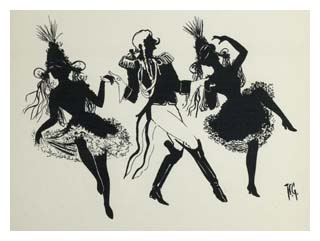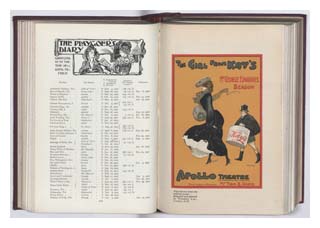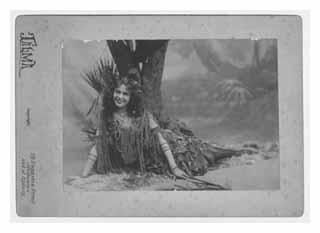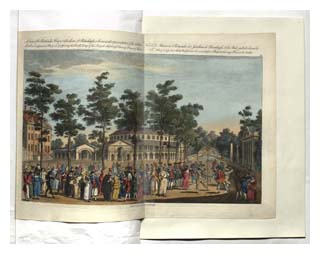Guide to the Archival Collections
This Guide to the Archival Collections gives an overview of each of the major contributing archives to this resource. It aims to give information on how material was selected and where it originates from, in order to give users a better understanding of the selection process.
- Senate House Library, University of London: The Harry Price Library of Magical Literature
- Senate House Library, University of London: The Malcolm Morley Collection
- Harry Ransom Center, University of Texas at Austin
- National Fairground Archive, University of Sheffield
- Vauxhall Gardens Collection, Lambeth Archives
- The May Moore Duprez Archive
- The British Library
- The Bill Douglas Cinema Museum
- British Film Institute National Archive
- Other contributing institutions
Harry Price Library of Magical Literature, Senate House Library, University of London (Spiritualism, Sensation & Magic)
The bulk of the original material in Spiritualism, Sensation & Magic was sourced from the Harry Price Library of Magical Literature. Price was an amateur conjuror and founder of the National Laboratory of Psychical Research, who made it his mission to expose frauds and tricksters operating in this field. His lifelong interest in magic in its widest sense – from conjuring tricks to psychic phenomena – led Price to amass a remarkable collection of materials on the history of magic and parapsychology. Harry Price deposited his “Collection of Magical Literature” with Senate House Library in 1937, and bequeathed it to the University on his death in 1948, requesting that it be known as the Harry Price Library of Magical Literature.
Harry Price gave himself a very wide bibliographic scope in which to collect. Works of fiction take their place alongside memoirs, biographies, treatises, histories, reports, books of practical instruction and magical texts. The total number of books, pamphlets and periodical titles in the Harry Price Library of Magical Literature amounts to nearly 13,000 items. From this huge collection our Consultant Editor, Professor Peter Otto (Chair of Literary Studies, University of Melbourne), has selected the most relevant items documenting the explosion of interest in the occult during the 19th and early 20th centuries, and the foundation of a new religious movement, Spiritualism.
Peter Otto has written a detailed introduction to the material sourced from this archive:
Spiritualism, Mesmerism, Psychical Science and secular magic together define the cultural field presented in this collection. It is concerned primarily with texts published during the “long” nineteenth century, from the beginnings of Mesmerism in 1779 through to the 1930s. Between these dates one can map the development, growth and decline of Mesmerism; the emergence, consolidation and eclipse of Spiritualism (or at least of its chief stages prior to the emergence of the New Age movement); the “heroic” phase of psychical research; and the “classic” phase of modern stage-conjuring. The collection in this first module of Victorian Popular Culture also includes a large number of conjuring books published before 1779, providing representative texts from each of the stages in the emergence of secular magic. Although the prime focus of this digital collection is works in English, significant works in other languages, particularly French, are included where appropriate. This module covers three subject sections:
- Popular Enchantments: Magicians, Conjurors and Illusionists
The first part of the collection includes: early works on magic and the creation of illusion (published before 1820); books and pamphlets on or by the key magicians and illusionists of the nineteenth and early twentieth centuries; and handbooks, manuals and introductions to stage- and parlour-magic. It maps the development of modern stage- and parlour-magic from Reginald Scot’s The discouerie of witchcraft (1584), Samuel Rid’s The art of iugling (1614), Henry Dean’s The Whole Art of Legerdemain (1722) and Henri Decremps’ The conjurer unmasked (1788), amongst many other texts, to the great magicians and illusionists of the 19th and early 20th centuries:
- Jean Eugène Robert-Houdin (1805-1871)
- The Great Wizard of the North (J. H. Anderson; 1814-1874)
- John Nevil Maskelyne (1839-1917)
- Charles Bertram (1853-1907)
- David Devant (1868-1941)
- Harry Houdini (1874-1926)
- Will Goldston (1877-1948)
- Robert Heller (1830-1878)
Among other treasures in the collection are the first twenty years of The Sphinx (1902-1922), perhaps the most significant of the conjuring journals published in the United States.
- Spiritualism: Mediums, Psychics and Spirits
This selection reproduces texts that document the rise of Spiritualism, with its attendant controversies. It focuses on accounts of, writings by, and exposés of the famous mediums of the nineteenth and early-twentieth centuries:
- Andrew Jackson Davis (1826-1910)
- The Davenport Brothers: Ira Davenport (1839-1911) and William Davenport (1841-1877)
- George T. Dexter
- Daniel Dunglas Home (1833-1886)
- William Stainton Moses (1840-1892)
- Maria Silbert (1866-1936)
- The Bangs Sisters (Mary and Lizzie)
- Leonora E. Piper (1857-1950)
Amongst the exposés of Spiritualism included in this part of the collection are John Nevil Maskelyne’s Modern Spiritualism: a short account of its rise and progress, with some exposures of so-called spirit media (1875) and The fraud of modern “theosophy” exposed: a brief history of the greatest imposture ever perpetrated under the cloak of religion (1900); and Herr Dobler’s (the Wizard of the North) Exposé of the Davenport brothers (1869).
Also included are the first four volumes of the important spiritualist journal Borderland (1893-97); the volumes of Light: A Journal of Psychical, Occult and Mystical Research, published between 1881 and 1885; works that reveal the connections between spiritualism and mesmerism, such as G. G. Zerffi’s Spiritualism and Animal Magnetism: A treatise on dreams, second sight, somnambulism, magnetic sleep, spiritual manifestations, hallucinations, and spectral visions (1871) and Louis Cahagnet’s The celestial telegraph, or, Secrets of the life to come, revealed through magnetism (1851); and books on spirit photography, such as Georgiana Houghton’s Chronicles of the photographs of spiritual beings and phenomena invisible to the material eye (1882), Thomas Slaney Wilmot’s Twenty photographs of the risen dead: with an account of the events which led to them being taken (1894), Andrew Glendinning’s The veil lifted: Modern developments of spirit photography (1894) and James Coates’ Photographing the invisible: practical studies in spirit photography, spirit portraiture, and other rare but allied phenomena (1911).
- From Mesmer’s ‘New Science’ to Animal Magnetism, Hypnotism and Psychical Research
The third selection gathers texts that together map the movement from the emergence of Mesmerism/Animal Magnetism in 1779 to its “flowering” in Victorian England and then its decline early in the twentieth century. It also reproduces key works of researchers who were members of, or associated with, the Society for Psychical Research (founded in 1882) and/or the American Society for Psychical Research (founded soon after). The unusual psychical and paranormal phenomena reported by Spiritualists and Animal Magnetisers provided the chief catalyst for the creation of these Societies, which numbered amongst their members both sceptics and believers in paranormal phenomena. This third selection is divided into six areas of interest:
- The founding works of Mesmerism:
Amongst the works collected here are Mémoire sur la découverte du magnétisme animal (1779), Mesmer’s “first and most influential public presentation of his theory of animal magnetism”, [1] and Aphorismes de M. Mesmer: dictés à l’assemblée de ses élèves, & dans lesquels on trouve ses principes, sa théorie & les moyens de magnétiser (1785), “A compilation of ‘class notes’ taken down from talks given by Mesmer to those he was training in the theory and practice of animal magnetism”. [2]
- Some of the varieties of early Mesmerism and books charting the emergence of magnetic somnambulism:
- The controversy that followed in the wake of the Franklin Commission into Animal Magnetism:
Texts by Jean-Baptiste Bonnefoy (1756-1790), Galart de Montjoie (1746-1816), Mesmer, and Joseph-Michel-Antoine Servan (1737-1807) are reproduced.
- Nineteenth-century authorities on Animal Magnetism:
This section includes texts by J. C. Colquhoun (1785-1854), John Bovee Dods (1795-1872), Baron Jules Du Potet de Sennevoy (1796-1881) and James Coates (1843-1933), along with many others.
- Mesmeric Periodicals:
The entire thirteen volumes of The Zoist (1843-1856), the most important journal of British Mesmerism, are reproduced.
- Psychical Researchers:
Key works of the most prominent psychical researchers are gathered in this section:
- John Bovee Dods (1795-1872)
- Frederick Myers (1843-1901)
- William Fletcher Barrett (1844-1925)
- Edmund Gurney(1847-1888)
- Sir Oliver Lodge (1851-1940)
- James Hervey Hyslop (1854-1920)
- Frank Podmore (1856-1910)
- Harry Price (1881-1948)
Amongst the names printed above, the most important for this collection is the last, the psychic researcher and amateur conjurer who built the “Collection of Magical Literature” from which this digital collection has been drawn. Harry Price concludes his introduction to the Short-title catalogue of his collection with the claim that its contents will allow students to become acquainted “with the work of every medium, magician, and – especially – charlatan who has graced the world’s psychic stage for the past five hundred years”. [3] This knowledge, as he explains in his foreword to the Catalogue’s Supplement, will “assist the student in the investigation of alleged phenomenal happenings; ... help him [sic] detect the psychic impostor and charlatan, and ... enable him to recognise a genuine phenomenon, if and when he sees one”. [4] These remarks nicely encapsulate perhaps the most appealing feature of the Harry Price Collection of Magical Literature, namely its collocation of a persistent scepticism; a recognition of the pleasures of enchantment; and a willingness to keep open the possibility of belief. One of the aims of this first module of Victorian Popular Culture is, through its choice of texts, faithfully to mirror these aspects of Price’s Library.
Although it is difficult to do justice to the remarkable diversity of material contained in Price’s Library of Magical Literature (the proposed collection does not substantially draw on the Library’s array of books on cryptography; extensive archive of newspaper and magazine articles; ephemera; and curious objects, such as séance equipment and yards of muslin which served mediums as ectoplasm), this project is intended as a homage to the Harry Price Library, as well as a self-standing collection in its own right.
Notes
[1] Adam Crabtree, Animal Magnetism, Early Hypnotism, and Psychical Research, 1766-1925 (White Plains, New York: Kraus International Publications, 1988), p. 4.
[2] Crabtree, Animal Magnetism, Early Hypnotism, and Psychical Research, p. 32.
[3] Harry Price, Short-title catalogue and supplementary catalogue of works on psychical research, spiritualism, magic, psychology, legerdemain, and other methods of deception, charlatanism, witchcraft, and technical works for the scientific investigation of alleged abnormal phenomena from circa 1450 A.D. to 1935 A.D.. Compiled by Harry Price, new intro by R.W. Rieber and Andy Whitehead (New York: Da Capo Press, 1982).
[4] Harry Price, Short-title catalogue and supplementary catalogue.
Harry Ransom Center, University of Texas, Austin
From the renowned Performing Arts holdings of the Harry Ransom Center (HRC), we include documents selected from several collections. Material from HRC features in the first three modules of this resource (Spiritualism, Sensation & Magic; Circuses, Sideshows & Freaks; Music Hall, Theatre & Popular Entertainment).
Harry Houdini (1874-1926) Collection (Spiritualism, Sensation & Magic) 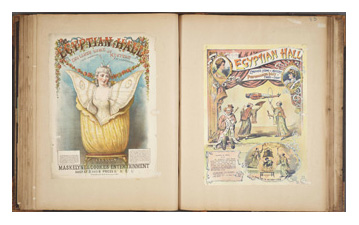
Harry Houdini, magician and escapologist, stunt performer, actor and film producer, was one of the great American celebrities of the early twentieth century. He also spent much of his life exploring spiritual phenomena and exposing fraudsters.
From his archive at the Harry Ransom Center, we include a number of beautiful and fascinating scrapbooks documenting the ‘History of Magic’, ‘Snake Charmers and Other Conjurors’, ‘Magic Illusions’ and ‘Spiritualism’. These are packed with details concerning the stagecraft of performers such as Houdin, Maskelyne and Dr Merlin, as well as providing insights into his disputes with Arthur Conan Doyle and leading spiritualists. There are also numerous photographs and over 100 magnificent posters.
Circuses, Sideshows & Freaks
For this module the Harry Ransom Center contributed a range of posters, programmes and playbills for circus companies such as Al G. Barnes, Adam Forepaugh, Sells Brothers, Sells-Floto, Astley’s Equestrian Wonders and Astley’s Royal Amphitheatre, Barnum and Bailey, Bannister’s Olympic Circus, Buffalo Bill’s Wild West Show, Clyde Beatty, Hagenbeck-Wallace, Ringling Bros. and Tom Mix. Principal collections are the Barnum and Bailey Circus Collection, and the Joe E. Ward Circus Collection.
Pantomime Collection (Music Hall, Theatre & Popular Entertainment)
The Harry Ransom Center’s Pantomime Collection is made up of ca. 400 items, 1793-1977 (bulk 1860-1910) relating to pantomime on the English stage, with a strong concentration on 19th century production. The collection is arranged by catalogue numbers as assigned by the dealer, Motley Books Limited.
The collection consists predominantly of printed scripts, programmes, souvenir programmes, and posters for numerous pantomimes, 1793-1952. From this collection we have selected fifty programmes and 85 printed scripts for a variety of pantomimes. Our selection aims to show the evolution of various pantomimes over the course of the long 19th century; for example, we have included 13 scripts for Aladdin from 1826 to 1900, which is a marvellous way to chart the evolution of the pantomime genre in this crucial period of its development. As well as familiar pantomimes such as Cinderella, Dick Whittington and Puss in Boots, there are unusual titles (Hop o’ my Thumb; Little Lallah Rookh; The Yellow Dwarf) and a wide selection of Harlequin scripts from the 18th and 19th centuries.
Theatre Buildings Collection (Music Hall, Theatre & Popular Entertainment)
The Theatre Buildings Collection, ca. 1760-1940 (bulk 1850-1920) is an unusual and fascinating visual collection of illustrations, engravings and plans of 19th century theatres – many now pulled down – in America and Europe. The Collection consists largely of prints and photographs of theatres, showing interior and exterior views. The bulk of the theatres depicted are in the United States, mainly New York City, but theatres in other countries are also represented. Also included are newspaper clippings, theatre tickets, architectural design plans, and seating plans.
Theatre Arts staff at the Harry Ransom Center assembled this collection from the Albert Davis Collection (photographs of buildings), the Messmore Kendall Collection (prints and other photographs), and others. From the collection we have selected a range of theatres in New York, London, Boston, Philadelphia, and elsewhere.
Prints Collection (Music Hall, Theatre & Popular Entertainment)
The Prints Collection, 1669-1906 (bulk 1775-1825) at the Harry Ransom Center consists of c.8,000 prints, the great majority of which depict British and American theatrical performers in character or in personal portraits. The collection is organised in three series: I. Individuals, 1669-1906 (58.25 boxes), II. Theatrical Prints, 1720-1891 (1.75 boxes), and III. Works of Art and Miscellany, 1827-1882 (1 box), each arranged alphabetically by name or subject. The prints found in this collection were made by numerous processes and include lithographs, woodcuts, etchings, mezzotints, process prints, and line blocks; a small number of prints are hand-tinted. A number of the prints were cut out from books and periodicals such as The Illustrated London News, The Universal Magazine, La belle assemblée, Bell’s British Theatre, and The Theatrical Inquisitor; others comprise sets of plates of dramatic figures such as those published by John Tallis and George Gebbie, or by the toy theatre publishers Orlando Hodgson and William West.
From this collection we have selected over 100 of the most visually and thematically interesting prints, which form a fascinating record of famous actors and productions from the period.
The National Fairground Archive, University of Sheffield
Material from the N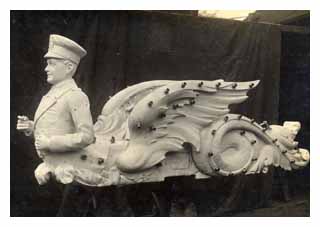 ational Fairground Archive (NFA) features in two sections of this resource, Circuses, Sideshows & Freaks and Music Hall, Theatre & Popular Entertainment.
ational Fairground Archive (NFA) features in two sections of this resource, Circuses, Sideshows & Freaks and Music Hall, Theatre & Popular Entertainment.
The NFA was inaugurated by the Vice Chancellor of the University of Sheffield in 1994, with the support of the Showmen's Guild of Great Britain and the Fairground Association of Great Britain. Housed in the Western Bank Library, it is a unique collection of photographic, printed, manuscript and audio-visual material covering all aspects of the culture of travelling show-people, their organisation as a community, their social history and everyday life; and the artefacts and machinery of fairgrounds.
The NFA collections are continuing to grow: there are now over 80,000 images in the photographic collection, in addition to audio and video material, journals and magazines, and nearly 3,000 monographs. The collection also includes a unique body of fairground ephemera (programmes, handbills, posters, charters and proclamations, plans and drawings).
From the NFA we have drawn a wide variety of sources, selected with the help of NFA staff and Professor Vanessa Toulmin, a Consultant Editor for Victorian Popular Culture.
The archive has contributed the following types of material for Circuses, Sideshows & Freaks:
Printed Books
An excellent range of very rare books, mainly focused on circuses and freakshows, including the following titles:
- Circus life and circus celebrities (1875)
- The lives of the conjurors (1881)
- The book of wonderful characters: memoirs and anecdotes of remarkable and eccentric persons in all ages and countries / chiefly from the text of Henry Wilson and James Caulfield [1869]
- Miss Alice Bounds, the Bear Lady
- Giants and Dwarfs (1868)
- Sketch of the life, personal appearance, character and manners of Charles S. Stratton, the man in miniature, known as General Tom Thumb (1851)
Ephemera
A huge range of ephemera covering all imaginable aspects of the entertainment industry is included. Ephemera is one of the great strengths of the NFA's acquisitions policy, and the selection here reflects the depth and range of their collections, covering subjects such as freaks, circuses, railway excursions, Barnum and Bailey, peepshows and much more. Materials include:
- Playbills
- Posters
- Stationery
- Cabinet Cards
- Postcards
- Playing cards
- Tickets
- Newspaper cuttings
John Bramwell Taylor Collection
The John Bramwell Taylor Collection comes from the estate of John Bramwell Taylor, a Yorkshireman who migrated to the South East of England during the 1930s and died in 2003. John Bramwell Taylor spent his working life as a porter at the Travellers’ Club in London and spent all his free time and money collecting printed ephemera. Very well known to dealers and collectors of ephemera, he had a deep and abiding knowledge of early printing history. He collected in all areas and the material that is now in the National Fairground Archive is only one small aspect of his collection. The collection largely consists of handbills, programmes and small flyers for shows, fairs, expositions and circus performances in the nineteenth century, which have been catalogued individually for the Victorian Popular Culture site.
Orton and Spooner Collection
Orton and Spooner were an amalgamation of two Burton upon Trent companies, George Orton and Charles Spooner, who worked together producing wagons and shows with elaborate carved work at the turn of the 19th century. They remained pioneering fairground manufacturers until 1954 after which they functioned as a light engineering company until their closure in 1977. From their archives we include the photographic collections, which are a fascinating record of fairground and entertainment architecture and decorative artwork.
The archive has contributed the following types of material for Music Hall, Theatre & Popular Entertainment:
Printed Books
A selection of very rare printed books on a range of subjects, focusing on unusual popular entertainments, including the magic lantern, waxworks and exhibitions. These include:
- Romance of Madame Tussaud’s (1921)
- The Magic Lantern: its construction and use [1889?]
- The art of ventriloquism : including full directions to learners how to acquire a pleasing vocalization, with amusing dialogues / by Frederick Maccabe [1894]
- Views of some of the most celebrated by-gone pleasure gardens of London : with some contemporary descriptions thereof (chiefly poetical) collected from various sources (1896)
- Cassell's illustrated family paper exhibitor : containing about three hundred illustrations, with letter-press descriptions of all the principal objects in the International Exhibition of 1862 (1862)
- The book of the lantern : being a practical guide to the working of the optical (or magic) lantern : with full and precise directions for making and colouring lantern pictures (1899)
- The pleasure haunts of London during four centuries / by E. Beresford Chancellor (1925)
- Glimpses of real life as seen in the theatrical world and in Bohemia : being the confessions of Peter Paterson, a strolling comedian (1864)
Posters, Programmes and Playbills
A varied selection of posters, programmes and playbills, including programmes from Madame Tussaud's, advertisements for Thomas Cook excursions, and posters for varied events, from opera to minstrelsy. A highlight is the wonderful and very rare collection of playbills from the Argyle Theatre in Birkenhead. The Hudson Collection of Early Sheffield Playbills from the University of Sheffield's special collections is also included in its entirety.
The Malcolm Morley Collection, Senate House, University of London (Music Hall, Theatre & Popular Entertainment)
Malcolm Morley (1890-1966) was a noted actor-manager and stage director. Born in London, he went to the US and Canada to pursue his theatrical career. He later returned to theatre in England. He actively collected material documenting the history of the theatre and this came to the University of London after his death.
The collection comprises over 4,000 individual items including theatrical periodicals, theatre histories, theatrical biographies and memoirs, works on stagecraft and the theatre in general, and printed texts of plays (including over 1,000 of Dicks’ Standard Plays).
For this project we have concentrated on the rarest material documenting the history of theatre from 1800 to 1910. Details of the larger collection can be found at the Senate House Library website. An obituary of Malcolm Morley is to be found in: Nath, G.W. 'Malcolm Morley', Theatre Notebook, 20 (1966): 98-99.
We have included a dozen of the most interesting titles such as:
- Actors By Daylight (1838) – heavily illustrated with a lot on traditional theatre in Victorian times
- The Players (1860-1861) – a wonderful resource for information on Victorian actors, with woodcut illustrations and interesting adverts
- The Era Almanack (1868-1919) – annual volumes describing all major theatres, theatrical agencies, and major productions and with useful biographies of key figures in the profession
- The Theatre Annual (1884, 1886, 1887) – an illustrated annual documenting individual productions and with features on noted players
- The Weekly Comedy (1881) – focuses on music hall entertainment
- The Playgoer (1901-1904) – featuring photographs and some colour plates, this is strong for music hall entertainment.
In addition there are individual volumes such as the Dramatic Author’s Society Provincial Tariff (1878-1882), which tells us what was played in provincial theatres across the UK and what the authors were paid, and the Stage Souvenir and The Play (1903-1904), which is a lavishly illustrated souvenir publication showing scenes from several productions.
Theatre Histories
There are some fascinating volumes describing regional theatre such as: Eugene Tompkins’ The History of Boston Theatre, 1854-1901 (1908); Henry Porter’s Theatres of Brighton (1886); M. E. Board’s The Story of the Bristol Stage, 1490-1925 (1925); James Dibdin’s The Annals of the Edinburgh Stage (1888); Walter Baynham’s The Glasgow Stage (1892); T. E. Pemberton’s The Criterion Theatre (c.1905); John Hollingshead’s The Story of Leicester Square (1893); Georges Cain on Anciens Théâtres du Paris (1906); and Harcourt Bosworth’s The Theatre Royal, Norwich (1903). There are also more general works on the history of American theatre and on the history of pantomime.
Theatrical Biographies
We include a handful of memoirs across a variety of genres, including recollections of Henry Irving, Junius Brutus Booth the Elder and Sarah Bernhardt, and also John Hare, Comedian, 1865-1895, and ‘Q’ on Dramatists of the Present Day (1871).
Works on Stagecraft and the Theatre in General
Items as diverse as Frank Archer’s An Actor’s Notebooks (1917), T. W. Erle’s Letters from a Theatrical Scene Painter (1859) and Cavendish Morton’s The Art of Theatrical Make Up (1909) help to illuminate the co-operative nature of theatrical productions.
Dicks’ Standard Plays
Many substantial collected editions of plays appeared during the 19th century. Notably:
- The London Theatre: A collection of the most celebrated dramatic pieces. Edited by T. J. Dibdin, 26 vols, 1815-1818.
- The New English Drama. Edited by W. Oxberry, 20 vols, 1818-1825.
- Duncombe’s British Theatre. Edited by John Duncombe, 67 vols, 1825-1852.
- Cumberland’s British Theatre. Edited by George Daniel, 48 vols, 1826-1861.
- The Acting National Drama. Edited by B. N. Webster, 18 vols, 1837-1859.
- Lacy’s Acting Edition of Plays. Edited by T. H. Lacy, 165 vols, 1849-1917.
- Dicks’ Standard Plays. Edited by John Dicks, 1,074 items, 1875-1908.
Dicks’ Standard Plays were one of the most popular editions and sought to provide over a thousand “FREE ACTING PLAYS, affording a benefit to Actor and Amateur, invaluable to both.” A near complete collection of these plays is held in the Malcolm Morley Collection at the University of London and these offer an invaluable insight into Victorian and Edwardian taste. A study of individual plays will give readers a vivid sense of the type of drama appearing on the British stage in this period. We have digitised over 300 of the 1,074 titles in the series, covering 383 plays. We have sought to provide a representation of all of the major authors featured and all of the major types of drama included. We have generally excluded commonly available texts, and those by authors from earlier periods (such as Shakespeare and Sheridan). In addition to digitising the plays, we also provide a complete list of Dicks’ Standard Plays, so scholars can see the full range of titles and can see which texts were chosen.
Scholars should be aware that a large number of Lacy’s Acting Editions of Plays are currently available online in the Victorian Plays Project. They have made available pdf versions of 339 plays. Only 36 of these duplicate plays on our list.
Vauxhall Gardens Collection, Lambeth Archives (Music Hall, Theatre & Popular Entertainment)
This collection is reproduced from material held in the Lambeth Archives Department. The department was formed in 1890, when William Minet gave the Minet Library to the joint vestries of Lambeth and Camberwell, and endowed it with his rich personal collection of material relating to the County of Surrey. When the Minet Library was rebuilt in 1959 after war damage, it became the official place of deposit for the archives of Lambeth Council. Lambeth Archives Department has previously been known as the Minet Library, and as the Surrey Collection. Although concentrating on Lambeth it still holds much unique and early material concerning the pre-1890 County of Surrey.
As the Boroughs of Lambeth and Southwark have a rich theatrical heritage, the department’s theatrical holdings are very interesting. Astley’s Amphitheatre, the Bower Saloon, the Surrey Theatre, the Old Vic and Canterbury Music Hall are particularly well documented. Material is held on other theatres, cinemas and music halls and there is a special collection on the Crystal Palace at Sydenham. In addition to the Vauxhall Gardens, Cupers Gardens and the Surrey Zoological Gardens are covered, but on a much smaller scale. The Vauxhall Gardens Collection is the name given to separate items, most of which were probably originally the property of William Minet. Nothing else is known of their provenance.
The Vauxhall Gardens Archive provides a wealth of information on many aspects of 18th and 19th century social life and entertainment. The Gardens opened in 1660 as a place of entertainment for Londoners on the South bank of the river Thames. This collection brings together a range of primary source documents which will allow us to assess the impact of the Gardens and the cultural history of London, and study the range of entertainments and leisure pursuits as they developed over a period of more than 200 years.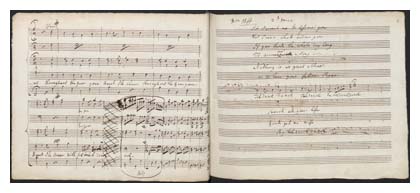
The material includes:
- Press cuttings and Play Bills, c.1732-1859
- Song Books and Music Sheets for Performances, c.1773-1859
- A Journal of Receipts, 1822-1859
- The Surrey Pamphlets
- Important illustrations of the Gardens including plans, sketches and images of a range of entertainments
- Bound volumes comprising weekly newsletters, background information on the history of the Gardens and additional pamphlets, ephemera, press cuttings and play bills, c.1660-1859.
The May Moore Duprez Archive (Music Hall, Theatre & Popular Entertainment)
May Moore Duprez (1880-1946) was a vaudeville and music hall star who achieved success on both sides of the Atlantic. She was most famous for her ‘Jolly Dutch Girl’ act, which was a blend of comic songs, dancing and witty repartee. Her archive remains in private hands and is made available to scholars for the first time in this digital resource. Ross King, her grandson, has written a brief biography of May Moore Duprez, which appears in the Essay section of this resource.
The collection, included in Music Hall, Theatre & Popular Entertainment provides a unique insight into the life and career of a music hall artiste who remained active from 1883 until 1936. It serves as an excellent case study for anyone wishing to understand how music hall worked, how the stars lived and what caused its decline. The Archive includes: diaries, letters and papers; press cuttings; programmes; posters and playbills; periodicals; photographs; and music.
Diaries, Letters and Papers
The most important items in this section are the two volumes of diaries describing her experiences abroad from 1900 to 1904. These give an astonishing account of her first visit to Britain in 1900 as part of a successful vaudeville double act. The act was initially unsuccessful and their tour was cancelled, but they fought to be given a second chance and were sent packing to Glasgow. They wowed the Scottish audiences and completed a tour throughout the UK, gradually building up a big following and moving up the bill. May Moore Duprez then had an acrimonious split with her music hall partner, but recovered to pursue a successful solo career. She subsequently toured Australia, New Zealand and South Africa. All of these incidents are described in her diaries, as well as very interesting descriptions of her accommodations when on tour, her reception by the press and audiences and the way in which she spent her spare time.
Also of interest to music hall scholars are the group of original music hall contracts, 1902-1918, showing the pay and conditions of music hall artistes of the period.
There are also a number of letters and other key personal documents.
Press Cuttings
There are five volumes of press cuttings and a number of loose cuttings in the collection. The earliest cuttings are from 1899 and describe The Moore Sisters or Moore & Duprez in performances in Philadelphia, New York and Columbus, Ohio. There are a good number of cuttings for the period from 1900 to 1926, covering her career in music hall in Britain, Australia, New Zealand and South Africa – with a few stray cuttings up to 1946. A final volume of cuttings collected by her husband, Bertram Grant, relate to cinema performances, 1929-1940, in West London. We have included these as we wished to digitise the archive in its entirety. The press cuttings give a great sense of how May’s act was received and how it changed over time.
Programmes
The Archive contains 60 programmes relating to performances across Britain from 1891 to 1927. Not all of these were for performances by May Moore Duprez, but they do give an insight into the range of shows and variety bills presented at playhouses from the provinces to the London Palladium. Pantomimes, variety shows and revues are all featured.
Posters & Playbills
There are 186 posters and playbills in the collection. In addition to being a rich visual resource, they also show the way in which the acts were billed and illustrate the variety of ‘turns’ in a single show.
Periodicals
There are extensive runs of four periodicals in the Archive:
- The Stage Souvenir, 1903
- The Theatre Magazine, 1906-1907
- The Play-Pictorial, 1902-1909
- The Performer, 1917 & 1921.
These are a really useful source for music hall scholars as they document many individual performances and provide pictures and accounts of leading performers. The advertisements are also of great interest.
Photographs
Over 400 captioned photographs describe May’s life and career from vaudeville, through music hall, pantomime and revue, to the advent of cinema. These include many interesting pictures of playhouses, productions and stars of the period.
Music
There are three music books (printed and manuscript) and 90 items of sheet music. Many of the songs were featured in May’s act – others are popular pieces of the period.
Resources for Scholars
We also offer five documents by Ross King, the grandson of Duprez, describing the life and career of May Moore Duprez:
- Miss May Moore Duprez: ‘The Jolly Dutch Girl’ by Ross King.
- The Diary of Minnie May Harris [May Moore Duprez]. Transcribed and annotated by Ross King.
- Early Newspaper Press Cuttings.
- Extracts from Various Magazine and Newspaper Articles.
- Appearance Dates of May Moore Duprez.
These can be viewed in our document viewer.
The British Library (Music Hall, Theatre & Popular Entertainment)
The third section of this resource, Music Hall, Theatre & Popular Entertainment, includes a number of unique items from the British Library. Several scrapbooks, comprised of a wide variety of ephemera, from engravings to newspaper cuttings, cover various popular entertainments in Britain from the late Georgian period. The scrapbooks cover the history of some of England's most famous pleasure gardens, including Ranelagh, Marylebone, and Surrey Zoological Gardens. Other highlights include a scrapbook of playbills, with information on private theatrical performances, and programmes of events held at the Royal Aquarium and the Royal Polytechnic, which hosted a series of scientific and literary lectures as well as musical entertainments. The collection includes a superb scrapbook compiled by prolific collector Sarah Sophia Banks. Banks’ scrapbook of over four hundred pages covers a range of human and animal curiosities. However, the largest group of material relates to ballooning, an activity that sparked public interest in the last quarter of the eighteenth century as the first experimental flights took place in Europe. The wonderful group of hand-coloured engravings, newspaper cuttings and handbills conveys Banks' fascination in ballooning and her interest in new experiments involving hot air.
The Bill Douglas Cinema Museum (Moving Pictures, Optical Entertainments & the Advent of Cinema)
The bulk of the original digitised material in Moving Pictures, Optical Entertainments & the Advent of Cinema was sourced from the Bill Douglas Cinema Museum 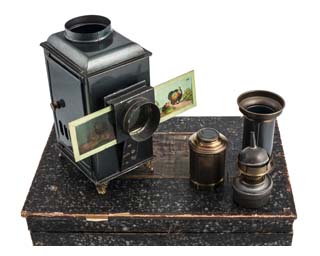 at Exeter University. Bill Douglas, along with friend and colleague Peter Jewell, was an early cinema enthusiast and a collector of memorabilia and ephemera related to cinema and its precursors.
at Exeter University. Bill Douglas, along with friend and colleague Peter Jewell, was an early cinema enthusiast and a collector of memorabilia and ephemera related to cinema and its precursors.
Like Bill, Peter’s passion for cinema started at a young age with a small “motley assortment” of cinema books obtained during his childhood. Together, they set about acquiring more and more items to fill in the gaps and by 1970 their collection contained over 500 books. With such solid foundations, the collection soon expanded and diversified to include printed ephemera, programmes, sheet music, cigarette cards, postcards, games, toys and other merchandise.
Whilst it was a lifelong ambition for the collection to one day become a museum, it was not until Bill’s tragic death from cancer in 1991 that his plans finally came to fruition. Peter found a home for their collection at Exeter University which commemorated Bill by opening the Bill Douglas Centre (now the Bill Douglas Cinema Museum) in 1994.
The collection sourced from the Museum amounts to nearly 6,000 items including 54 objects that we have captured for users to experience in a 360-degree viewer. The online virtual Optical Entertainments exhibition also features video clips of a selection of optical entertainment artefacts in action.
Periodicals
We have selected over 260 periodicals from the Museum from the early 19th century and spanning over 100 years of visual entertainment and cinema-going. Some notable titles include:
- Pictures and the Picturegoer
- The Illustrated London News
- The Mirror: of literature, amusement, and instruction
- Harmsworth magazine
- The Pictures: an illustrated weekly of news and fiction for lovers of moving pictures
- Illustrated Films Monthly
- The Saturday Magazine
- The Boy’s Own Paper
Printed Books
We have selected over 260 printed books from the Bill Douglas Cinema Museum from the early 19th century and spanning over 100 years of optical entertainment and cinema literature, including:
- Practical Cinematography / F. Talbot [1913]
- Playwriting for the cinema / Ernest A. Dench [1914]
- How Motion Pictures are Made / Homer Croy [1918]
- The Magic Lantern and its Management / T. C. Hepworth [1885]
- The Horse in Motion / J. Stillman and Eadweard Muybridge [1882]
- Les Ombres Chinoises de Mon Père / Paul Eudel [1885]
Ephemera
The fascinating collection of printed ephemera in this resource ranges from:
- Trade cards
- Programmes
- Cinema tickets
- Business cards
- Film can labels
- Invitations
- Cigarette cards
- Postcards
- Posters
- Handbills
Objects
Module four of Victorian Popular Culture is unique in its inclusion of visual objects and artefacts, from:
- Ombrascopes and silhouettes
- Thaumatropes
- Kinoras, flick-books and mutoscopes
- Phenakistiscopes, zoetropes and praxinoscopes
- Zograscopes
- Telescopic and perspective views
- Magic lanterns and slides
- Phonograph cylinders
- Cinematographs
British Film Institute National Archive (Moving Pictures, Optical Entertainments & the Advent of Cinema)
The fourth module of this resource, Moving Pictures, Optical Entertainments & the Advent of Cinema, includes a selection of original film footage from the BFI National Archive from 1894-1926. The clips are an assortment of dramatic sequences, actualities, special-effect films and comedies from some of the most influential production companies of the era such as Pathé Frères, Mitchell and Kenyon, Edison and the Kinetoscope Exhibiting Company, the American Mutoscope Company, Topical Film and Hepworth & Co. The collection also features some of the big stars of the day including Charlie Chaplin, Mary Pickford, Roscoe "Fatty" Arbuckle and Rudolph Valentino, as well as some iconic early films. These include: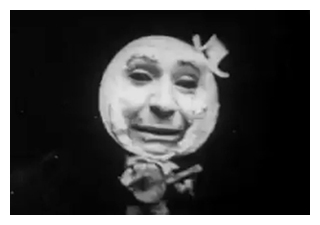
- Upside Down; or the Human Flies (1899)
- Leonard - Cushing Fight (1894)
- The Miller and the Sweep (1897)
- Grandma’s Reading Glass (1900)
- Mister Moon (aka Moon Man) (1901)
- Rip Van Winkle (1896)
- Charlie on the Ocean (1921)
- The Cup Final 1923 - Exclusive (1923)
- Fatty Arbuckle (1920)
- The Passing of Rudolph Valentino (1926)
Other Contributing Institutions
The National Archives (UK) have contributed posters and photographs, with an emphasis on representations of freaks and oddities for the module Circuses, Sideshows & Freaks. Chetham's Library, Manchester provided a selection of regional playbills and broadsides (mainly from the 18th and early 19th century) from the Cambrics Scrapbook, for inclusion in Music Hall, Theatre & Popular Entertainment.


